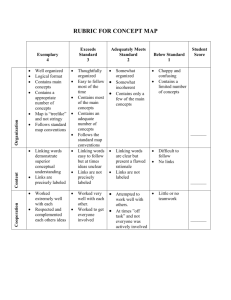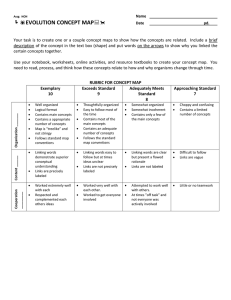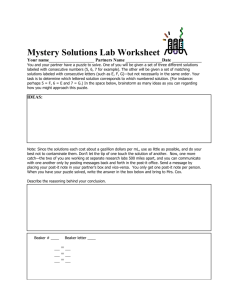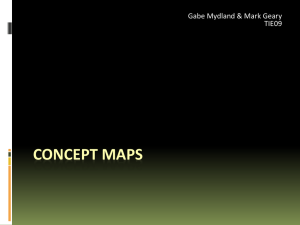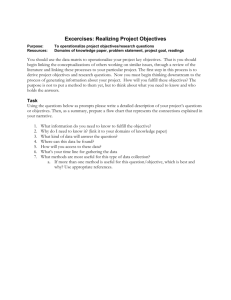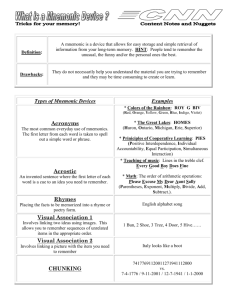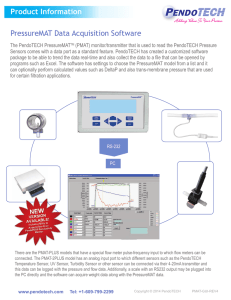Presentation
advertisement
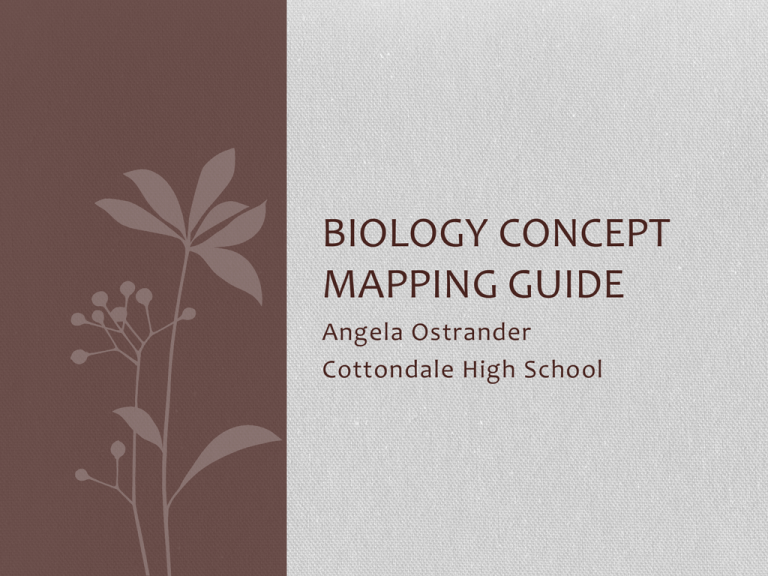
BIOLOGY CONCEPT MAPPING GUIDE Angela Ostrander Cottondale High School Constructing a Concept Map • Brainstorming Phase: From your memory, (which you can jog by going through your notes and related course material) identify facts, terms, and ideas that you think are in anyway associated with the topic. Make a list of these items and print them neatly on small Post-It® notes, one per note, in very brief form, i. e. a single word or short phrase. This is a brain-storming process, so write down everything that anybody in your group thinks is important and avoid discussing how important the item is. Don't worry about redundancy, relative importance, or relationships at this point. Your objective here is to generate the largest possible list you can. Before your group completes this step, you may have more than 50 items. • Organizing Phase: Spread out your concepts (Post-It® notes) on a flat surface so that all can be read easily and, together, create groups and sub-groups of related items. Try to group items to emphasize hierarchies. Identify terms that represent those higher categories and add them. Feel free to rearrange items and introduce new items that you omitted initially. Note that some concepts will fall into multiple groupings. This will become important later. • Layout Phase: On a large sheet of paper, try to come up with an arrangement (layout) that best represents your collective understanding of the interrelationships and connections among groupings. Feel free to rearrange things at any time during this phase. Use a consistent hierarchy in which the most important concepts are in the center or at the top. Within sub-grouping, place closely related items near to each other. Think in terms of connecting the items in a simple sentence that shows the relationship between them. Do not expect your layout to be like that of other groups. It may be advisable to meet outside of class to work on this assignment and plan for its completion. • Linking Phase: Use lines with arrows to connect and show the relationship between connected items. Write a word or short phrase by each arrow to specify the relationship. Many arrows can originate or terminate on particularly important concepts. • Finalizing the Concept Map: After your group has agreed on an arrangement of items that coveys your understanding, you need to convert the concept map into a permanent form that others can view and discuss. Be creative in a constructive way through the use of colors, fonts, shapes, border thickness, etc. to communicate your group's understanding. Give your concept map a title. If you want to construct your final concept map on a computer, try using PowerPoint. Example Concept Map http://en.wikipedia.org/wiki/File:Concep tmap.gif#file Grading Considerations • Accuracy and Thoroughness. Are the concepts and relationships correct? Are important concepts missing? Are any misconceptions apparent? • Organization. Was the concept map laid out in a way that higher order relationships are apparent and easy to follow? Does it have a title? • Appearance. Was the assignment done with care showing attention to details such as spelling and penmanship? Is it neat and orderly or is it chaotic and messy? • Creativity. Are there unusual elements that aid communication or stimulate interest without being distracting? Concept Mapping Rubric Organization Excellent 4 Well organized Logical format Contains main concepts Contains a appropriate number of concepts Map is “treelike” and not stringy Follows standard map conventions Content Poor 2 Thoughtfully organized Easy to follow most of the time Contains most of the main concepts Contains an adequate number of concepts Follows the standard map conventions Failing 1 Somewhat organized Somewhat incoherent Contains only a few of the main concepts Student Score Choppy and confusing Contains a limited number of concepts _______ Cooperation Good 3 Linking words Linking words easy to demonstrate superior follow but at times conceptual ideas unclear understanding Links are not precisely Links are precisely labeled labeled Worked extremely well with each Respected and complemented each others ideas Worked very well with each other. Worked to get everyone involved Linking words are clear but present a flawed rationale Links are not labeled Attempted to work well with others. At times ”off task” and not everyone was actively involved Difficult to follow No links _______ Little or no teamwork _______ Concept Mapping Words 1. 2. 3. 4. 5. 6. 7. 8. 9. 10. 11. 12. Meiosis Mitosis PMAT PMAT 1 PMAT 2 Diploid Haploid Chromosome Codominant DNA Dominance Gamete 13. 14. 15. 16. 17. 18. 19. 20. 21. 22. Genetics Heredity Law of Segregation Law of Independent Assortment Law of Dominance Model Offspring Polygenic Recessive Replication
